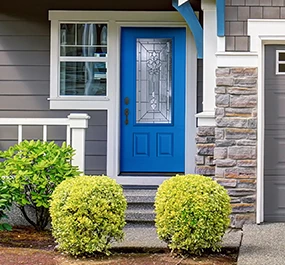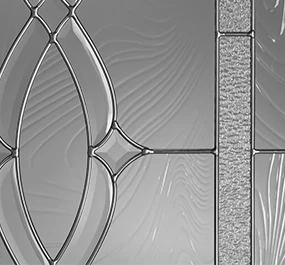If your door has started to sag, it can be frustrating to deal with your door scraping the door jamb, or even getting stuck. However, this is an easy fix that can usually be addressed without replacing your front door or paying someone to come and fix your sagging door.
There are a variety of issues that can cause a sagging door, but the most common are:
- Loose hinges
- A spacer added to the top hinge
- Loose hinge screws
- Additional coats of paint or stain
Each of these issues can push your door out of alignment, resulting in a sagging door.
How to fix a sagging door
Fixing a sagging door will depend on the source of the problem. The first step (tightening loose hinges) is the most common, effective way to fix a sagging door—however, if this does not solve the issue, it’s important to troubleshoot and decide which of the next steps is the best course of action.
1. Tighten loose hinges
Using a screwdriver, tighten the screws on both sides of the hinge, starting with the top hinge. To avoid stripping the screws, it’s important to not use a drill for this. If any of your hinge pins rattle or move while you’re tightening the hinges, it’s likely the hinge has loosened over time and will need to be replaced entirely. If the other two are still in good condition, replacing the old one will suffice.
2. Remove hinge spacers
Hinge spacers, also known as hinge shims, can be used during door installation to make adjustments to the alignment of the door. However, if the door is sagging, there may be an issue with the spacer. It may have shifted over time or, depending on the type and material, may be damaged and no longer usable. If your hinges have spacers, try removing the hinge screws and hinge to slide the spacer out, and re-tighten the hinges without the spacer.
Depending on the exact nature of the issue, removing the spacer may solve the issue. However, in the case of damage, the spacer may need to be replaced. As always, it’s best to consult with a professional to determine the best solution and, if need be, to properly install a new spacer.
3. Add new hinge screws
If you noticed one or more of your screws continued to rotate instead of tightening during step one, you’ll need to replace those hinge screws. It’s not necessary to replace the ones that tighten correctly—just the ones that continue to rotate instead of tightening. Generally, hinge screws are 1 inch, but you should measure yours to be certain. Replace 1 inch hinge screws with 1 ½ inch screws.
If you’d like to go a step further, an effective fix for a sagging door is to replace the middle screw of the top hinge on the door jamb side with a 3 inch screw. This will bring the hinge closer to the door jamb, and as a result, bring the entire door closer. To do this, remove the highest screw closest to the door stop, on the door jamb side, and using a screwdriver, put the 3 inch screw in the center hole before replacing the other two screws.
4. Remove excess paint or stain
If you’ve had your door for a while and it has gone through multiple coats of stain and paint, additional paint or stain underneath the hinge can accumulate and cause the door to sag. Scrape off any paint that has accumulated, then re-screw your hinges back onto your door.
Minimize your maintenance needs with Plastpro
While an annoying problem to deal with as a homeowner, fixing a sagging door should be doable once you learn how. Plastpro aims to provide resources to preserve the door you already have. We also recommend this video, with a method to adjust your door by bending the hinges. However, if it is a recurring issue—or if other issues arise—you may consider a new door or frame.
Plastpro’s fiberglass doors and PF door frames are a great choice for minimizing the amount of maintenance needed on your entryway. Our fiberglass doors and composite door frames are extremely durable and less likely to warp or rot, especially compared to wood doors. This keeps your entryway strong, secure, and beautiful for years.
Find a dealer near you to see Plastpro’s selection of doors and frames.



